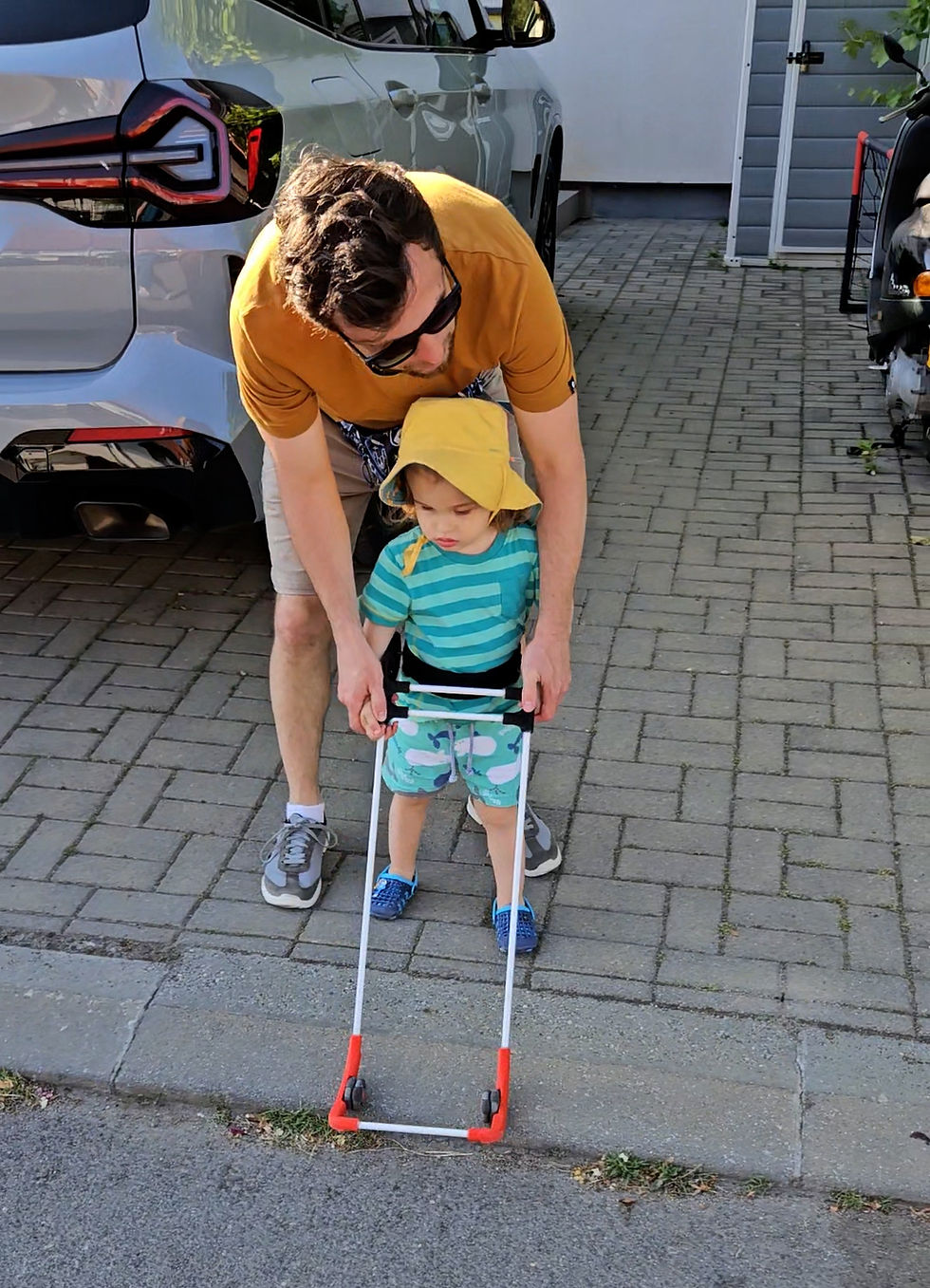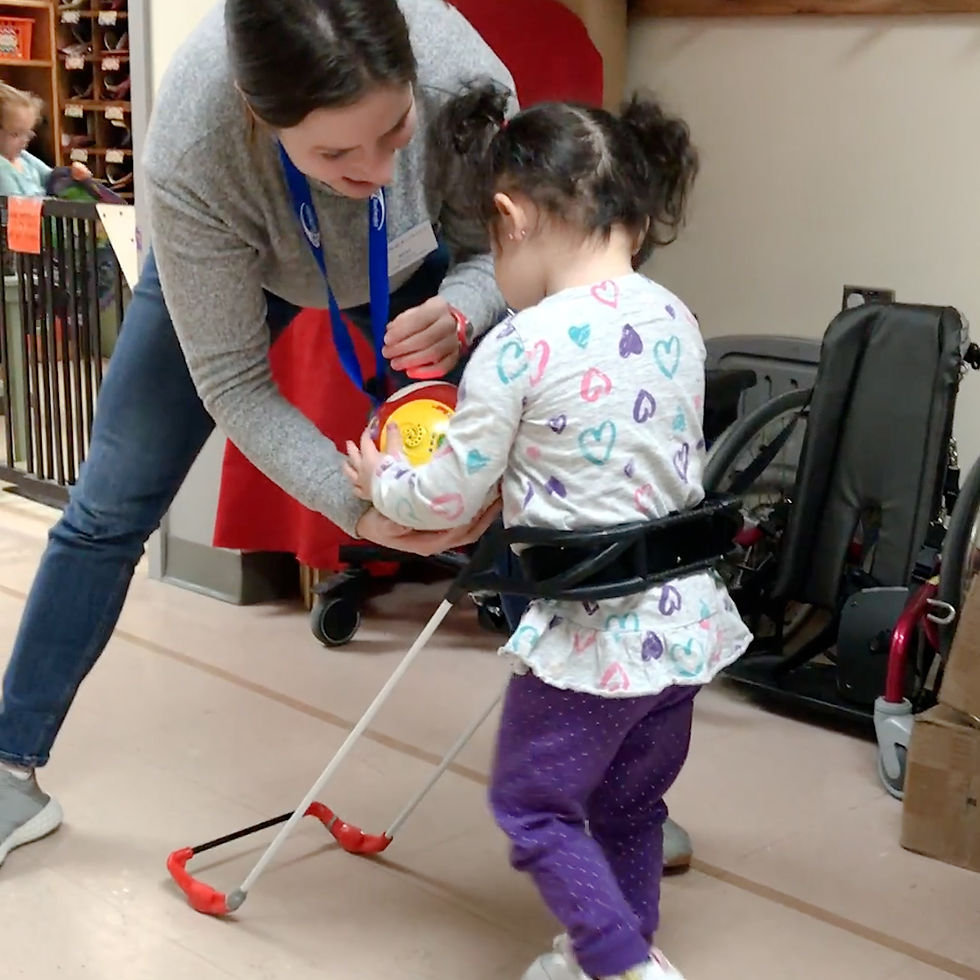Every Parent of a Blind Child Knows the Importance of Touch Feedback to Walking
- Grace Ambrose-Zaken

- Jul 7
- 5 min read
Updated: Jul 22
Understanding how your child with a Mobility Visual Impairment or Blindness (MVI/B) moves can be both exciting and overwhelming. As parents, we often wait in anticipation for those precious moments when our little ones hit their mobility milestones. These milestones are crucial as they indicate your child's physical development and can impact their ability to interact with the world around them. Knowing what to expect and when can help you support your child's growth effectively.
Child Movement Stages
Children typically move through several stages before they learn to walk, run, and jump with confidence. Each stage is marked by significant physical achievements that help strengthen their muscles and coordination. There is a variety of child movement stages every parent should be familiar with, so let's take a closer look.
Imagine your child at just a few months old, discovering their body. At this stage, they begin by mastering head control, which is essential for future mobility. By around four months, most babies can lift their heads while lying on their stomach. As they continue to grow, they gain additional skills that lay the groundwork for walking.

As your child approaches the six-month mark, they may start to roll over. This is often a big milestone that allows them to explore more of their surroundings. By seven to nine months, many babies begin to sit up unassisted, showcasing their core strength. This progress not only allows them greater independence but also encourages further exploration.
Studies suggest that nurturing an active environment for babies with an MVI/B can significantly help your child's development. To boost their motor skills, you may choose to engage them with toys that encourage reaching, grasping, and crawling. Creating a safe space for them to play can accelerate these development stages.

What are the milestones for a child to walk?
As your child with an MVI/B grows, the next big milestone is learning to walk. This skill typically develops between the ages of 9 to 15 months, although every child is unique. Here are the key milestones leading up to walking:
1. Crawling (6-10 Months)
Crawling is a significant milestone, as it strengthens the muscles in the arms, legs, and core. It also enhances your child's spatial awareness. Babies may crawl in different styles, such as the traditional hands-and-knees crawl, army crawling, or scooting on their bottoms. Encouraging them to crawl through playtime will facilitate their growth and curiosity.
2. Pulling Up to Stand (9-12 Months)
Once your child is familiar with crawling, they will likely try to pull themselves up to a standing position. This means they are beginning to understand balance and coordination. By providing sturdy furniture or toys to aid this process, you create an environment that supports their development.
3. Cruising (10-14 Months)
Cruising involves moving along furniture while holding on for support. This stage is vital as it gives your child practice with balance and coordination. Encourage this behavior by placing toys just out of reach, prompting them to move and explore.

4. Taking First Steps (12-15 Months)
Those magical first steps typically happen around the age of one. Some children may take longer, but that's there is an age range. You can encourage this milestone by holding your child’s hands and letting them walk with you. It's also helpful to create a safe environment by having your child with an MVI/B wear a belt cane to aid in balance, protection, and information.

Factors Influencing Mobility Development
Many factors can influence when children achieve their mobility milestones. Genetics, environment, and opportunities for movement all play a part. Research indicates that children who are encouraged to explore their environment tend to develop their mobility skills at a faster rate. The child with an MVI/B will pair these explorations with the belt cane. Parents can help fix the cane, teach them how to keep the cane in front, how to use the cane to investigate and how to make good choices about which path to walk on and which one to avoid.
Give Them Space
While it’s essential to guide your child, it's equally important to provide them with the freedom to explore. Engage in play where walking is not just a way to get to fun, but a way to express oneself. Put the belt cane on and let them learn through natural movement, engaging with others, and age-appropriate play.

Monitor Progress
It’s important to keep track of your child's progression through these stages. Look for signs that indicate they are ready to advance to the next stage. If you have concerns about your child's mobility, consider consulting their pediatrician. Early intervention can make a significant difference in their development.
Creating a Safe Environment for Movement
Safety is paramount as your child begins to move around. Here are some actionable tips to create a safe environment:
1. Baby-proof Your Home
Remove sharp objects, toxic substances, and anything that could cause falls. Use baby gates to prevent access to stairs or areas that could pose risks.
2. Encourage Active Play
Incorporate active play into their daily routine. Simple activities such as rolling a ball, playing chase, or hide-and-seek while wearing their mobility device can boost their strength and confidence.
3. Limit Screen Time
Research shows that excessive screen time can obstruct physical activity. Encourage your child to engage in real-life experiences instead of virtual ones. This can help them develop their mobility skills and social interactions simultaneously.

Celebrate Their Achievements
As your child reaches each milestone, make sure to celebrate their achievements. Positive reinforcement can build confidence and a love for movement. Whether it’s a simple "good job" or a family celebration, the encouragement will motivate them to keep exploring and trying new things.
The Journey of Becoming Active
Understanding the stages of child mobility milestones can help you provide the right support for your child's development. Remember that each child is different, and they will progress at their own pace. Understanding this can alleviate worries about their growth and ensure that your expectations align with what is developmentally appropriate.
As parents, learning to support our children through these child mobility milestones gives us insight into their growth and development. Embrace each stage, as it signifies your child's journey toward becoming agile and independent. Let's cherish these moments and foster an environment that encourages ongoing exploration and movement—one tiny step at a time!








Comments